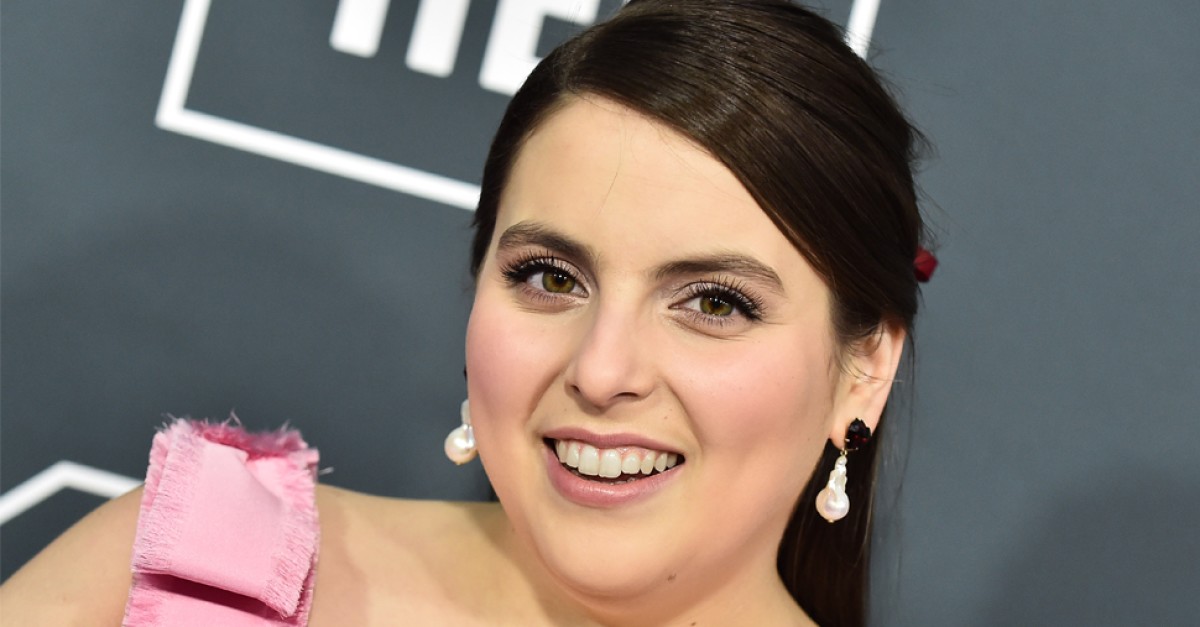by Webmaster | Aug 11, 2021 | New Musical News Feed
After a week of buzz and speculation (and a casting call notice), producers Sonia Friedman and Scott Landis have confirmed that they will bring a Funny Girl revival to Broadway, with Beanie Feldstein taking on the role of Fanny Brice. Performances will begin in spring 2022, with a theatre, exact dates, and further casting to come.
Tony winner Michael Mayer will direct the production, having helmed a London revival that began at the Menier Chocolate Factory and later transferred to the West End. While Menier is a producer of the Broadway bow—and while the New York revival will feature a revised book by Harvey Fierstein following his work in London—the production itself will not be a transfer of that staging. Joining the creative team are set designer David Zinn, choreographer Ellenore Scott, and tap choreographer Ayodele Casel.
Feldstein made her Broadway debut in the recent revival of Hello, Dolly!. On screen, she’s had standout roles in Booksmart and Lady Bird, and will soon be seen as Monica Lewinsky in the Ryan Murphy limited series Impeachment: American Crime Story. Some of her upcoming film roles speak to her theatre ties: the movie adaptations of The Humans and Merrily We Roll Along (which is to be filmed over a two-decade period).
The stage and screen favorite says she’s played the famed comedian before, albeit on a smaller scale: “The first time I played Fanny Brice was at my third birthday party, in a head-to-toe leopard print outfit my mom made for me. So, it’s safe to say that stepping into this iconic role, on Broadway and not in my family’s backyard, is truly my lifelong dream come true.”
READ: Movie Adaptation of The Humans Will Premiere at Toronto International Film Festival
This will mark the first Broadway revival of Funny Girl since the original 1964 production catapulted Barbra Streisand to stardom. The musical, featuring a score by composer Jule Styne and lyricist Bob Merrill and an original book by Isobel Lennart, was slated to be revived in 2012 in a production directed by Bartlett Sher, though the plans fell through as investors backed out.
Look Back at Barbra Streisand in Funny Girl on Broadway
by Webmaster | Aug 9, 2021 | New Musical News Feed
A new theatre opens on Broadway August 10 with a show that kept a couple of old ones alive for quite a while on the other side of the Atlantic.
When the lights go up at the dazzling new Marriott Marquis Theatre, they will blaze onto Me and My Girl, a chirpy cockney musical that became a landmark in London before and during WWII and then returned there after a 35-year hiatus to an equally triumphant reception. This second coming was crowned by a coveted Olivier Award (the equivalent of a Tony) for the young English actor Robert Lindsay, who now heads the otherwise all-American cast featuring Maryann Plunkett and George S. Irving at the Marquis.
At the heart of this nostalgic singalong is one very simple idea, which dates back to 1936 when Lupino Lane (a British singing comedian along the lines of Lindsay, Jim Dale and Michael Crawford) suggested to the composer Noel Gay that there might be a show to be written about a poor young South London lad who suddenly finds himself heir to a fortune and has, therefore, to learn all about life among the upper classes.
Already it was, of course, a kind of reversed Pygmalion, but 30 years before My Fair Lady the idea had never been set to music. When it opened in 1937, the show got off to a slow start. But one night early in the run BBC radio had to cancel a broadcast and decided instead to relay some of Me and My Girl live from the Victoria Palace Theatre. It was the first time the West End had ever been broadcast, and when radio listeners at home heard Lupino Lane doing “The Lambeth Walk” to cheers of delight from stalls and gallery alike, they decided they had to visit the theatre too. As a result Me and My Girl ran for the next five years, despite being bombed out of two theatres early in the war, and “The Lambeth Walk” became everything from a Coronation anthem in 1937 (it was the year George VI inherited the crown from his abdicating brother Edward VIII) to a military marching song in 1940.
The real success of Me and My Girl has always had to do with its immediacy and its accessibility. Like Broadway’s George M. Cohan, Noel Gay wrote the kind of songs that ordinary theatregoers not only sang in their baths but probably also thought they could write in their baths: sunny, optimistic, patriotic numbers that seldom taxed either brain or pen. Indeed, Gay’s most quintessential and popular song has a chorus of only seven words, of which only two are different and only one has more than one syllable: “Run, rabbit, run, rabbit, run, run, run.”
But like most of Cohan’s work, Gay’s Me and My Girl also seemed to disappear into oblivion when the curtain rang down on its final performance in the early ’40s. London, like Broadway, had moved on to other things (the year Me and My Girl closed was the year Oklahoma! opened) and no one was giving odds on ever again seeing another professional production of Gay’s mega-hit.
No one, that is, except Gay’s son Richard Armitage, a distinguished theatre and music agent in London. Armitage decided that if the book were somewhat rewritten and if some of the best of Gay’s songs from other shows could be added to the score, then Me and My Girl could perhaps be brought back to an increasingly nostalgic West End.
But that still left a central casting problem. The “Me” of Me and My Girl is a cockney wide-boy, Bill Snibson, who learns that he is by birth an aristocrat and is then pressured by his newly-discovered relations to become upper class and forget his Lambeth sweetheart, the Sally who is “My Girl.” The twist on the old Pygmalion plot that became My Fair Lady is that in this case both Bill and Sally get two-way tickets into the aristocracy, so that they can always go back to the wrong side of the tracks afterwards. Whether or not the show works depends on the playing of Snibson. It’s one of those roles a young Danny Kaye might have coveted, since on the printed page only about half of it really exists: all the rest is business and charisma and a talent for pratfalls, and to find a Lupino Lane around London now would be like setting out to find George M. Cohan having a pre-theatre drink in Sardi’s.
Brilliantly, Armitage as the producer and Mike Ockrent his director, therefore, went right to the other end of the stage spectrum, and to an actor who had made an altogether different reputation in the classical theatre (a notable Hamlet at the Royal Exchange and Edmund in Olivier’s last King Lear and Benedick in a recent BBC television Much Ado About Nothing) and in several domestic dramas and situation comedies on the small screen. Robert Lindsay had, however, started out in musicals, playing small roles alongside David Essex in the rock film That’ll Be The Day and the original London stage Godspell, and remembering this, the management offered him the role in Me and My Girl that he now re-creates on Broadway. “The funny thing is,” said Lindsay recently, “that I originally turned this down two or three times. It seemed very out of date as a script, and I just couldn’t see it working for the 1980s. But then they persuaded me to take a tape of the music away with me on holiday, and when I played ‘The Sun Has Got His Hat On’ and ‘Leaning On a Lamppost’ and ‘Love Makes The World Go Round,’ I thought this really is a lot of fun. Then again, I had terrible doubts when they first asked me to come to Broadway with it because the whole thing seemed so terribly English and London-based, so I said no again, and it wasn’t until they pointed out to me that half the audiences we played to in the West End last summer were in fact American tourists that I realized maybe Americans were understanding it after all.”
One might add that Broadway has a long tradition of cockney musicals, going back through Half a Sixpence and Oliver! and Stop the World to My Fair Lady itself, which was a Broadway creation despite its Covent Garden setting. One might also add that not since Jim Dale and (in London) Michael Crawford first took to the stage as Barnum has there been a musical performance of such manic energy as that now given by Mr. Lindsay here. As Michael Coveney noted in the Financial Times, “like all great performers, he has the knack of making you feel utterly secure even while he is involved in the most complicated stage activity, shimmying and dodging like a boxer or emitting vegetable-stall cries in the midst of quite normal conversations. He is both stylish and engaging, not all that common a pairing of qualities, but one that indicates a star.”
“I think I really agreed to Me and My Girl,” continues Lindsay, “because of my father. He had been a trade union man all his life and it was just at the time of the miners’ dispute, and everything and everyone in Nottinghamshire, where he lives, was very gloomy, and Dad said, ‘That’s it, that’ll cheer them up, just do it,’ and he was right. But it was only when I began meeting the American tourists who gave us standing ovations every night last summer in London that I realized what was really happening here. This was the England they had come all the way over to see, and they found that in real life it just didn’t exist any more. But then at the Adelphi Theatre they discovered aristocrats with tennis racquets on country lawns and a little man in a funny pork-pie hat saying ‘Wotcher, me old China,’ and they loved it.”
And no wonder. Me and My Girl is a celebration of the English at their most characteristically mindless. But for sheer musical charm and comic invention it may prove hard to beat on Broadway. As for Robert Lindsay, he embodies a leggy, all-singing, all-dancing musical comedy talent of a kind rarely seen since the days of the great Ray Bolger himself.


